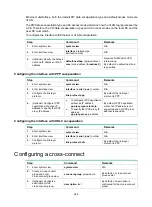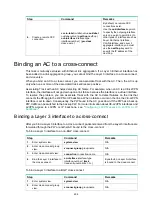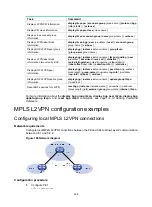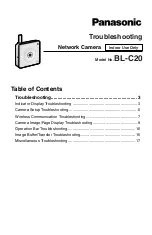
393
P-tag, the PE adds a null label (the label value is 0) into the packet, and then
encapsulates the packet.
−
If the peer PE requires the ingress to rewrite the P-tag, the PE changes the P-tag to the
expected VLAN tag (the tag value might be 0), and then adds a PW label and an outer
tag into the packet. If the packet contains no P-tag, the PE adds a VLAN tag expected by
the peer PE (the tag value might be 0), and then adds a PW label and an outer tag into
the packet.
{
For a packet to a CE:
−
If the access mode is configured as VLAN by using the
ac
interface
command, the PE
rewrites or retains the P-tag before forwarding the packet.
−
If the access mode is configured as Ethernet by using the
ac
interface
command, the
PE removes the P-tag before forwarding the packet.
Ethernet over MPLS supports the following modes:
•
Port
mode
—A Layer 3 Ethernet interface is bound to a PW. Packets received from the Layer 3
Ethernet interface are forwarded through the bound PW. The default PW data encapsulation
type for port mode is Ethernet.
Figure 102 Packet encapsulation in port mode
•
VLAN
mode
—A Layer 3 Ethernet subinterface is bound to a PW. Packets received from the
VLAN are forwarded through the bound PW. The peer PE can modify the VLAN tag as needed.
The default PW data encapsulation type for VLAN mode is VLAN.
PPP/HDLC over MPLS
PPP/HDLC over MPLS uses MPLS L2VPN to connect PPPs or HDLC networks, and delivers PPP or
HDLC packets through a PW over the MPLS backbone.
If the link type of the AC is PPP, the PW data encapsulation type is PPP. If the link type of the AC is
HDLC, the PW data encapsulation type is HDLC.
PPP/HDLC over MPLS supports only the port mode. You can associate a Layer 3 interface whose
encapsulation type is PPP or HDLC with a PW.
In a PPP/HDLC over MPLS network, a PE processes a PPP or HDLC packet as follows:
1.
After receiving a packet from a Layer 3 interface, the PE searches for the PW bound to the
interface.
2.
The PE encapsulates the packet and sends the packet to the peer PE through the PW.
3.
The peer PE removes the outer encapsulation to get the original PPP or HDLC packet, and then
forwards the packet to the user network.
















































